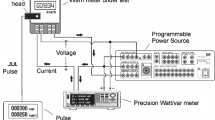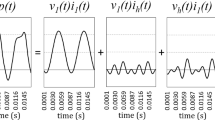Abstract
The influence of distortions in voltage and current waveforms on state-of-the-art single-phase and three-phase power meters, commonly used in the utility power system of the Slovak Republic, was studied. A computer-controlled test system capable of generating nonsinusoidal voltages and currents and a reference power quality analyzer were used for this purpose. The results of the experiments on several revenue meters are presented. Some samples exhibited high errors under the tests, while the others operated within their tolerance limit. The overview of the current standards and previously published related studies on the operation of electric energy measuring equipment under determined and random nonsinusoidal conditions is given. The discussion including possible explanations of the phenomenon supervised under the conducted tests is provided.






Similar content being viewed by others
References
Djokic S, Langella R, Meyer J, Stiegler R, Testa A, Xu X (2017) On evaluation of power electronic devices’ efficiency for nonsinusoidal voltage supply and different operating powers. IEEE Trans Instrum Meas 66(9):2216–2224
Carstens H, Xia X, Yadavalli S (2018) Measurement uncertainty in energy monitoring: present state of the art. Renew Sustain Energy Rev 3:2791–2805
Handbook for Electricity Metering, 11th ed. Edison Electric Institute (2014)
ANSI/ASHRAE, ASHRAE Guideline 14 - 2014 Measurement of Energy, Demand, and Water Savings (2014)
“Uniform Methods Project,” National Renewable Energy Laboratory (NREL). [Online]. https://www.nrel.gov/ump/
“Directive 2014/32/EU of the European Parliament and of the Council,” Off. J. Eur. Union (2014)
Bernieri A, Betta G, Ferrigno L, Laracca M, Schiano Lo Moriello R (2013) Electrical energy metering: some challenges of the European Directive on Measuring Instruments (MID). Meas J Int Meas Confed 46:3347–3354
“Active electrical energy meters, Final Draft International Recomendation IR46,” Organisation Internationale de Metrologie Legale, 2013. [Online]. http://2013.oiml.org/publications/final_drafts/FDR_R46-1-2.pdf. Accessed 30 Aug 2019
EN 50470-1:2006+A1:2018. Electricity Metering Equipment (a.c.)—part 1: general requirements, tests and test conditions—metering equipment (Class Indexes A, B and C). Brussels, Belgium: CENELEC (2018)
Przydatek P (2018) Regulating accuracy: impacts of changes in ANSI C12.1 and ANSI C12.20. Schneider Electr. white Pap., 13 p
IEC 62053-21:2003+A1:2016. Electricity Metering Equipment (a.c.)—particular requirements—Part 21: static meters for active energy (Class 1 and 2). Geneva, Switzerland: IEC (2016)
IEC 62053-23:2003+A1:2016. Electricity metering equipment (a.c.)—particular requirements—Part 23: static meters for reactive energy (classes 2 and 3). Geneva, Switzerland: IEC
IEC 62053-24:2003+A1:2016. Electricity metering equipment (a.c.)—particular requirements—Part 24: static meters for reactive energy at fundamental frequency (Classes 0,5 S, 1 S and 1). Geneva, Switzerland: IEC
Arseneau R, Filipski PS (1988) Application of a three phase nonsinusoidal calibration system for testing energy and demand meters under simulated field conditions. IEEE Trans Power Deliv 3(3):874–879
Filipski PS, Labaj PW (1992) Evaluation of reactive power meters in the presence of high harmonic distortion. IEEE Trans Power Deliv 7(4):1793–1799
Domijan A, Embriz-Santander E, Gilani A, Lamer G, Stiles C, Williams CW (1996) Watthour meter accuracy under controlled unbalanced harmonic voltage and current conditions. IEEE Trans Power Deliv 11(11):64–72
Driesen J, Van Craenenbroeck T, Van Dommelen D (1998) The registration of harmonic power by analog and digital power meters. IEEE Trans Instrum Meas 47(1):195–198
Morva G, Volokhin V, Diahovchenko I, Čonka Z (2017) Analysis of the impact of nonlinear distortion in voltage and current curves on the errors of electric energy metering devices. In: 2017 IEEE first Ukraine conference on electrical and computer engineering (UKRCON), pp 528–533
Diahovchenko I, Volokhin V, Kurochkina V, Špes M, Kosterec M (2019) Effect of harmonic distortion on electric energy meters of different metrological principles. Front Energy 13(2):377–385
Diahovchenko I, Kolcun M, Čonka Z, Savkiv V, Mykhailyshyn R (2020) Progress and challenges in smart grids: distributed generation, smart metering, energy storage and smart loads. Iran J Sci Technol Trans Electr Eng 44:1319–1333
Zhang J, Luo D, Zhang Q, Zhang B, Zhu L, Wen H (2019) Evaluation of comprehensive maximum error of power energy meter based on OIML recommendation R46. In: Proceedings of the World congress on intelligent control and automation (WCICA), pp 1031–1036
Cataliotti A, Cosentino V, Lipari A, Nuccio S (2009) Metrological characterization and operating principle identification of static meters for reactive energy: an experimental approach under nonsinusoidal test conditions. IEEE Trans Instrum Meas 58(5):1427–1435
Novotny J, Drapela J, Topolanek D (2016) Frequency response of revenue meters in measured active energy. In: Proceedings of international conference on harmonics and quality of power, ICHQP, pp 524–529
Macedo JR, Xavier GL, Gondin IN, Oliveira LTS, de Oliveira RFB (2020) An update on the performance of active energy meters under non-sinusoidal conditions. Electr Eng 102:1785–1794
Leferink F, Keyer C, Melentjev A (2016) Static energy meter errors caused by conducted electromagnetic interference. IEEE Electromagn Compat Mag 5(4):49–55
Olencki A, Mroz P (2014) Testing of energy meters under three-phase determined and random nonsinusoidal conditions. Metrol Meas Syst 21:217–232
Wang X, Wu D, Yuan R, Jiang Z, Yang J (2020) Dynamic test signal modelling and a compressed sensing based test for electric energy meter errors. Meas J Int Meas Confed 164:107915
Volokhin V, Diahovchenko I, Kurochkina V, Kanálik M (2017) The influence of nonsinusoidal supply voltage on the amount of power consumption and electricity meter readings. Energetika 63(1):1–7
Volokhin VV, Diahovchenko IM, Derevyanko BV (2017) Electric energy accounting and power quality in electric networks with photovoltaic power stations. In: 2017 IEEE international young scientists forum on applied physics and engineering, YSF 2017, pp 36–39
Shevchenko SY, Volokhin VV, Diahovchenko IM (2017) Power quality issues in smart grids with photovoltaic power stations. Energetika 63(4):146–153
Kirkham H (2019) Reactive power and power factor. Power-Globe Archives, 2019. [Online]. https://listserv.nodak.edu/cgi-bin/wa.exe?A0=POWER-GLOBE. Accessed 30 Sep 2019
Steinmetz CP (1899) Symbolic representation of general alternating waves and of double frequency vector products. Trans Am Inst Electr Eng 16:269–296
Budeanu C (1927) Reactive and fictitious powers, vol 2. Romanian National Institute, Bucharest
Frize S (1932) Active reactive and apparent power in circuits with nonsinusoidal voltage and current. Elektrotechnische Zeitschrift 53(25):596–599
Shepherd W, Zakikhani P (1972) Suggested definition of reactive power for nonsinusoidal systems. Proc IEE 119(9):1361–1362
Czarnecki LS (1985) Considerations on the reactive power in nonsinusoidal situations. IEEE Trans Instrum Meas 34(3):399–404
Emanuel AE (2010) Power definitions and the physical mechanism of power flow
Bucci G, Ciancetta F, Fiorucci E, Ometto A (2017) Survey about classical and innovative definitions of the power quantities under nonsinusoidal conditions. Int J Emerg Electr Power Syst 18(3):20170002
IEEE (2010) “IEEE Standard definitions for the measurement of electric power quantities under sinusoidal, nonsinusoidal, balanced, or unbalanced conditions,” IEEE Std 1459-2010 (Revision of IEEE Std 1459-2000)
Xavier GL et al (2020) An update on the performance of reactive energy meters under non-sinusoidal conditions. Electr Eng 102:1881–1891
Chiampi M, Crotti G, Morando A (2011) Evaluation of flexible rogowski coil performances in power frequency applications. IEEE Trans Instrum Meas 60(3):854–862
Volokhin VV, Diahovchenko IM, Derevyanko BV (2017) Prospects of nanomaterials use in current and voltage hall sensors to improve the measurements accuracy and reduce the external impacts. In: Proceedings of the 2017 IEEE 7th international conference on nanomaterials: applications and properties, NAP 2017, pp 03NE08-1–03NE08-5
Cataliotti A et al (2019) Compensation of Nonlinearity of Voltage and Current Instrument Transformers. IEEE Trans Instrum Meas 68(5):1322–1332
Crotti G, Gallo D, Giordano D, Landi C, Luiso M, Modarres M (2017) Frequency response of MV voltage transformer under actual waveforms. IEEE Trans Instrum Meas 66(6):1146–1154
Kang Y-C, Zheng T-Y, Kim Y-H, Lee B-E, So S-H, Crossley PA (2011) Development of a compensation algorithm for a measurement current transformer. IET Gener Transm Distrib 5(5):531–539
Cataliotti A, Cosentino V, Di Cara D, Nuccio S, Tinè G (2015) Rogowski coil current transducer compensation method for harmonic active power error. Meas J Int Meas Confed 63:240–251
Volokhin V, Diahovchenko I (2017) Peculiarities of current sensors used in contemporary electric energy metering devices. Energetika 63(1):8–15
Volokhin VV, Diahovchenko IM (2016) The use of nanocrystalline and amorphous materials for electric energy metering improvement and reducing the effects of external magnetic fields. In: Proceedings of the 6th international conference nanomaterials: applications and properties, NAP 2016, pp 02NEA03-1–02NEA03-3
Diahovchenko I, Mykhailyshyn R, Danylchenko D, Shevchenko S (2019) Rogowsky coil applications for power measurement under non-sinusoidal field conditions. Energetika 65(1):14–20
IEC 62052-11:2003+A1:2016. Electricity Metering Equipment (a.c.)—general requirements, tests and test conditions—part 11: Metering Equipment. Geneva, Switzerland: IEC
EN 50470-3:2006+A1:2018. Electricity Metering Equipment (a.c.)—part 3: particular requirements—static meters for active energy (Class Indexes A, B and C). Brussels, Belgium: CENELEC
Vieira D, Shayani RA, De Oliveira MAG (2017) Reactive power billing under nonsinusoidal conditions for low-voltage systems. IEEE Trans Instrum Meas 66(8):2004–2011
Diahovchenko I, Lebedinskyi I (2019) Operational peculiarities of electric energy meters of different types in power networks with harmonic distortions. Energetika 65(4):161–171
Cataliotti A, Cosentino V (2008) A time-domain strategy for the measurement of IEEE standard 1459–2000 power quantities in nonsinusoidal three-phase and single-phase systems. IEEE Trans Power Deliv 23(4):2113–2123
Acknowledgements
This work was supported by the Slovak Research and Development Agency under the Contract No. APVV-15-0438.
Author information
Authors and Affiliations
Corresponding author
Additional information
Publisher's Note
Springer Nature remains neutral with regard to jurisdictional claims in published maps and institutional affiliations.
Rights and permissions
About this article
Cite this article
Diahovchenko, I., Dolník, B., Kanálik, M. et al. Contemporary electric energy meters testing under simulated nonsinusoidal field conditions. Electr Eng 104, 1077–1092 (2022). https://doi.org/10.1007/s00202-021-01365-8
Received:
Accepted:
Published:
Issue Date:
DOI: https://doi.org/10.1007/s00202-021-01365-8




